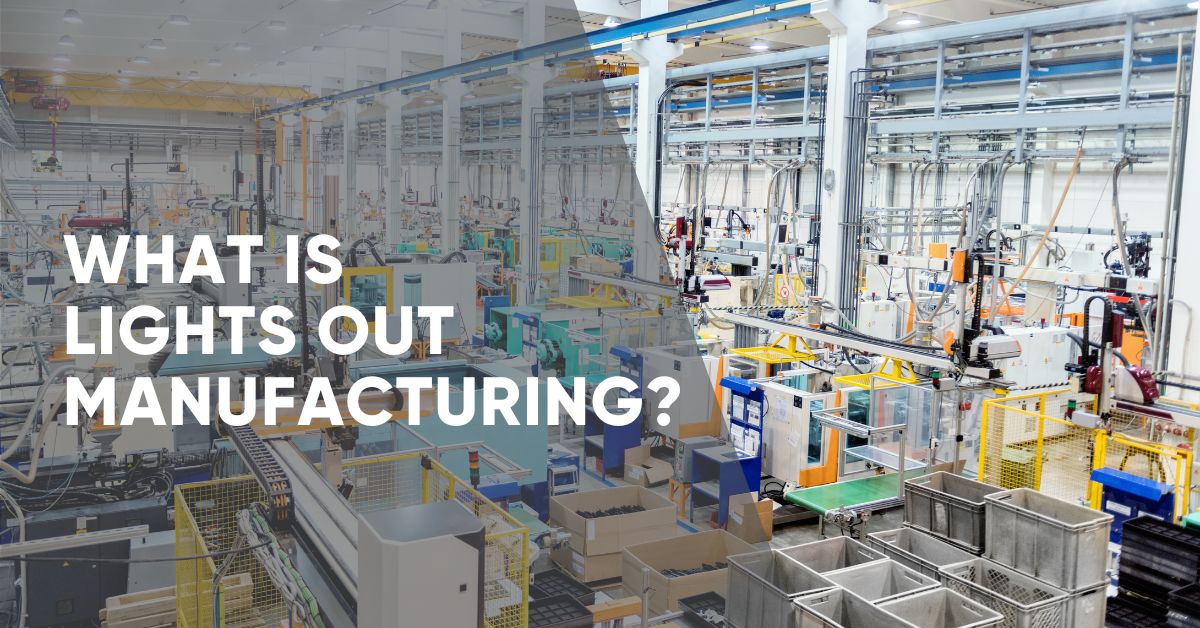A lights out manufacturing system, or “LOM”, is an automated production process that runs without the need for direct human supervision or intervention. The goal of a lights out manufacturing system is to reduce labor costs, increase efficiency and minimize human error. This is achieved by using advanced technologies such as robotics, artificial intelligence, and machine learning algorithms.
Lights out manufacturing systems can operate 24 hours a day, 7 days a week without breaks, ensuring consistent and continuous production. This not only increases the overall output but also helps to meet the demands of fast-paced and constantly evolving industries. In addition, lights out manufacturing systems can also be programmed to perform multiple tasks, reducing the need for multiple workers to be present at the same time.
COMPONENTS OF A LIGHTS OUT MANUFACTURING PLANT
The components of a lights out manufacturing plant may vary depending on the specific industry and manufacturing process, but some common components include:
Robotics
Industrial robots are a key component of lights out manufacturing, performing tasks such as material handling, assembly, and packaging. The robots are typically programmed using computer-aided design (CAD) software and can be controlled by a central computer system.
Automated Material Handling
Materials need to be transported and handled automatically to and from various machines in the plant. This can include robotic arms, conveyors, and automated guided vehicles (AGVs).
Quality Control Systems
Lights out manufacturing require reliable and robust quality control systems to ensure that products meet the required quality standard thresholds. This can include automated testing and inspection systems, such as vision systems, that can detect defects and ensure consistency in product quality.
Sensors and Data Collection
To operate autonomously, a lights out manufacturing plant requires sensors and data collection devices to monitor the manufacturing process and detect any issues that may arise. This data is typically fed into a central computer system that can analyze it in real-time and make adjustments to the manufacturing process as needed.
Centralized Control System
A central computer system is used to control the manufacturing process, including robots, material handling systems, and quality control systems. The computer system uses data received from sensors and other data collection devices to make decisions to optimize the manufacturing process.
Energy and Utilities Management Systems
A lights out manufacturing plant requires a reliable and efficient energy and utilities management system to ensure that power and other utilities are supplied without interruption. This can include backup power systems and intelligent energy management systems that optimize energy usage and reduce waste.
Overall, a lights out manufacturing plant requires highly advanced and integrated systems to operate efficiently and effectively without human intervention.
WHAT ROLE DOES AI PLAY?
Artificial Intelligence (AI) algorithms and Machine Learning (ML) techniques are used to monitor and control various aspects of the production process such as process optimization, quality control, and predictive maintenance.
One of the key benefits of AI in LOM is the ability to perform real-time analysis of production data, including machine performance, product quality, and resource utilization. This data is used to make informed decisions about process optimization and to identify areas for improvement.
For example, AI algorithms can be used to determine the optimal set points for key process variables, such as temperature, pressure, and speed, based on historical data and real-time production conditions.
Another important application of AI in LOM is predictive maintenance. AI algorithms can analyze data from sensors and other sources to identify patterns and anomalies in machine behavior. This information can be used to predict when a machine is likely to fail, allowing for proactive maintenance and reducing the risk of unplanned downtime.
In addition, AI is also being used to improve quality control in LOM systems. AI algorithms can be trained to detect defects in real-time, and to identify the root causes of these defects. This information can be used to improve the manufacturing process and to prevent the production of defective products.
Lights out manufacturing systems can also be integrated with other technologies such as sensors and data analytics to collect and analyze production data. This data can be used to optimize production processes, identify bottlenecks, and improve overall efficiency. Lights out manufacturing systems can also be programmed to make real-time decisions, such as adjusting production speed or changing production processes based on the current demand.
A lights out manufacturing system is a highly efficient and flexible production method that can help businesses reduce costs, increase efficiency, and keep up with the demands of fast-paced industries.
AI helps to improve the efficiency, reliability, and flexibility of these systems, enabling manufacturers to achieve greater levels of automation and optimization in their production processes. By using advanced technologies, lights out manufacturing systems are helping to transform the way businesses operate and ensuring that they remain competitive in today’s rapidly changing global marketplace.
CLEAROBJECT SUCCESS STORY
ClearObject been successful in helping businesses automate their manufacturing plants leveraging machine vision and artificial intelligence on the edge to operate sophisticated manufacturing processes 24/7 without human intervention. This transformation has delivered increases in product quality, output, and uptime while reducing production costs. Read about the company that digitally transformed its manufacturing processes with the help of ClearObject.


